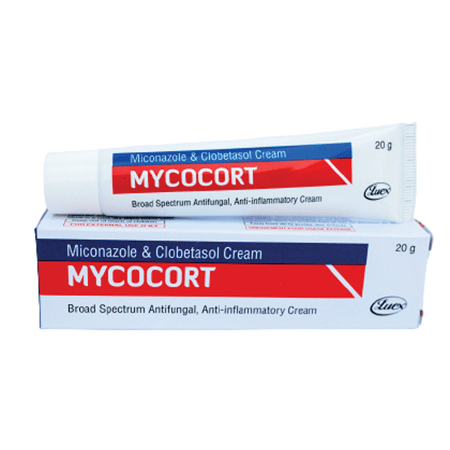Mycocort Cream
Side Effects
- Burning or stinging sensation
- Skin irritation
- Skin thinning
- Allergic reactions (Rare)
Serious side effects are uncommon, but if you experience severe allergic reactions or persistent irritation, seek medical attention promptly.
Frequently Asked Questions
What is Mycocort Cream used for?
Mycocort Cream is used to treat fungal infections of the skin, such as ringworm and athlete’s foot, especially when they are accompanied by symptoms like redness, swelling, or itching.
How does Mycocort Cream work?
Miconazole kills fungi by disrupting their cell membranes, while Clobetasol reduces inflammation, itching, and redness, making the cream effective for fungal infections with inflammatory components.
Can I use Mycocort Cream for eczema?
Mycocort Cream can be used to treat fungal infections with inflammatory symptoms, but it is not a first-line treatment for eczema alone. For eczema without fungal infection, your healthcare provider may recommend a different corticosteroid cream.
What should I do if my symptoms don’t improve?
If your symptoms do not improve after 2 weeks of using Mycocort Cream, stop use and consult your healthcare provider for further advice or alternative treatments.
Can I use Mycocort Cream on broken skin?
Avoid applying Mycocort Cream to broken or damaged skin, as this can increase the risk of side effects. Use the cream only on intact skin.
Can Mycocort Cream be used on the face?
Mycocort Cream should not be used on sensitive areas like the face unless directed by a healthcare provider. The skin on the face is thinner and more prone to the side effects of corticosteroids.
Got Questions or need to speak to a specialist?
You can reach out to us via email at support@luexhealthcare.com
Category
Antifungal & Anti-inflammatory (Topical)
Best For
Skin Itching, Redness, Swelling etc

Mycocort Cream is a combination of two active ingredients: Miconazole, an antifungal agent, and Clobetasol, a potent corticosteroid. It is designed to treat fungal skin infections that are accompanied by inflammation, itching, and redness. Miconazole works by inhibiting the growth of fungi, while Clobetasol reduces inflammation and relieves itching, redness, and swelling associated with skin conditions. Mycocort Cream is particularly useful in treating fungal infections that are complicated by eczema or other inflammatory skin conditions.
- Miconazole Nitrate: 2% (per gram of cream)
- Clobetasol Propionate: 0.05% (per gram of cream)
Mycocort Cream is indicated for the treatment of:
- Fungal infections of the skin (such as ringworm, athlete’s foot, and jock itch) with inflammation
- Fungal infections that are associated with inflammatory skin conditions like eczema
- Apply a thin layer of Mycocort Cream to the affected area once or twice daily, as prescribed by a healthcare provider.
- Gently rub the cream into the skin.
- Do not use for more than 2 weeks unless directed by a healthcare provider.
- Avoid applying to broken skin or large areas of the body for extended periods, as Clobetasol is a potent steroid.
Trusted By More Than 500,000,000 Happy People
Join the Luex Healthcare family for a guranteed healthy life and general well-being.
